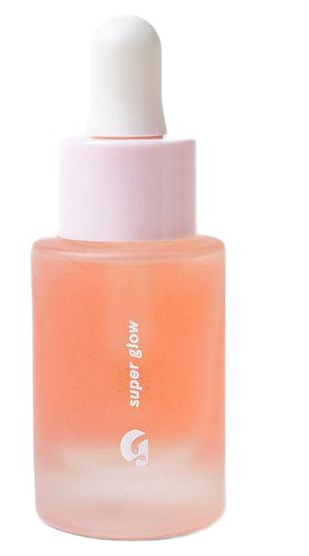
Super Glow (Discontinued)
Highlights
Key Ingredients
Skim through
| Ingredient name | what-it-does | irr., com. | ID-Rating |
|---|---|---|---|
| Water/Aqua/Eau | solvent | ||
| Glycereth-26 | moisturizer/humectant, emollient, viscosity controlling | 0, 0 | |
| Propanediol | solvent, moisturizer/humectant | ||
| Aminopropyl Ascorbyl Phosphate | antioxidant, skin brightening | goodie | |
| Magnesium Pca | moisturizer/humectant | ||
| Ethylhexylglycerin | preservative | ||
| Phenoxyethanol | preservative |
Glossier Super GlowIngredients explained
Good old water, aka H2O. The most common skincare ingredient of all. You can usually find it right in the very first spot of the ingredient list, meaning it’s the biggest thing out of all the stuff that makes up the product.
It’s mainly a solvent for ingredients that do not like to dissolve in oils but rather in water.
Once inside the skin, it hydrates, but not from the outside - putting pure water on the skin (hello long baths!) is drying.
One more thing: the water used in cosmetics is purified and deionized (it means that almost all of the mineral ions inside it is removed). Like this, the products can stay more stable over time.
It's a nice glycerin-based humectant and emollient that gives skin a smooth and luxurious feel.
Propanediol is a natural alternative for the often used and often bad-mouthed propylene glycol. It's produced sustainably from corn sugar and it's Ecocert approved.
It's quite a multi-tasker: can be used to improve skin moisturization, as a solvent, to boost preservative efficacy or to influence the sensory properties of the end formula.
A vitamin C derivative that's created by combining ascorbic acid (pure vitamin C) with a molecule called 3-APPA (it stands for 3-aminoproply dehydrogen phosphate). If you do not know what the big deal about vitamin C is, you are missing out, and you have to click here and read all the geeky details about it.
So now, you know that vitamin C is awesome. It's proven to have antioxidant, collagen-boosting and skin-brightening magic abilities, but the problem is that it's really really unstable. To solve the stability issue, the cosmetic industry is coming up with derivatives and Aminopropyl Ascorbyl Phosphate (AAP) is a newish version created by a Korean company.
According to the manufacturer, AAP is a water soluble, stable derivative that has both anti-wrinkle and whitening effects. They conducted an in-vivo (made on real people) study with 33 participants and found that the test formula, with just 0.5% AAP, "significantly" reduced hyperpigmentation (age spots) after 8 weeks (by 29-33%). They also measured a "dramatic" decrease in the total number of wrinkles, about 23% after 8 weeks. (If that's dramatic, we are not sure. Also, be patient because after 4 weeks, the wrinkle reduction was only a couple of percent.)
As for published studies on AAP, we found hardly anything. We found one done by Estee Lauder that briefly mentions AAP as an antioxidant that adds additional UV protection to sunscreen formulas. Another one done by Oriflame reviewed skin-whitening ingredients and also briefly mentioned AAP as a skin-lightening active.
Overall, there is not much data on Aminopropyl Ascorbyl Phosphate, but it does seem like a promising derivative with antioxidant, anti-wrinkle and skin-brightening properties. If you are into vitamin C derivatives and are happy to experiment, it's worth a go.

If you have spotted ethylhexylglycerin on the ingredient list, most probably you will see there also the current IT-preservative, phenoxyethanol. They are good friends because ethylhexylglycerin can boost the effectiveness of phenoxyethanol (and other preservatives) and as an added bonus it feels nice on the skin too.
Also, it's an effective deodorant and a medium spreading emollient.
It’s pretty much the current IT-preservative. It’s safe and gentle, but even more importantly, it’s not a feared-by-everyone-mostly-without-scientific-reason paraben.
It’s not something new: it was introduced around 1950 and today it can be used up to 1% worldwide. It can be found in nature - in green tea - but the version used in cosmetics is synthetic.
Other than having a good safety profile and being quite gentle to the skin it has some other advantages too. It can be used in many types of formulations as it has great thermal stability (can be heated up to 85°C) and works on a wide range of pH levels (ph 3-10).
It’s often used together with ethylhexylglycerin as it nicely improves the preservative activity of phenoxyethanol.
You may also want to take a look at...
| what‑it‑does | solvent |
| what‑it‑does | moisturizer/humectant | emollient | viscosity controlling |
| irritancy, com. | 0, 0 |
| what‑it‑does | solvent | moisturizer/humectant |
| what‑it‑does | antioxidant | skin brightening |
| what‑it‑does | moisturizer/humectant |
| what‑it‑does | preservative |
| what‑it‑does | preservative |





